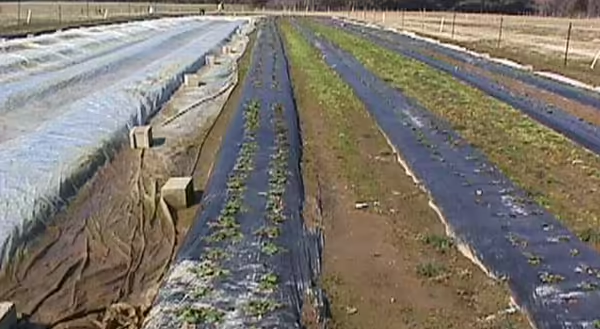
In the southern region, it is time to get prepared for uncovering strawberries in both annual plasticulture and matted row systems. When you start checking strawberry growth under covers, what you find underneath is quite different between the two systems.
Straw, the primary cover in the matted row system, blocks light to the plant, which results in little growth over winter (dormancy) and almost complete decay of the previous canopy of leaves. We usually recommend two events to help target when to rake off straw (including dead leaf material). First, check for new strawberry leaf growth every couple of days, especially early fruiting varieties. This usually coincides with soil temperature in the upper two- to four inches reaching the 40°F mark. New leaves will develop from the crowns and usually are green to greenish yellow. Remove straw as soon as possible upon seeing new growth, with the suggested caveat of delaying for a few days if the short-range forecast predicts a string of very cold days. Otherwise, don’t delay. Remember, it is the first runners developing in cool temperatures that tend to be most productive…you want to get growth going as soon as possible, without setting yourself up for freeze injury to the plant.
Floating row covers, depending on thickness, allow a certain portion of light to pass through, and are the primary winter cover for plasticulture strawberries. With the combined soil heat from the black plastic mulch, the plants never really go dormant and continue to grow to some extent over winter. When uncovered, it is not uncommon to find plants still retaining a significant number of green leaves, though there are still ragged leaves that need to be cleaned up for disease management; but the point is these plants are further along in their development and some actually need to be slowed down by pulling row covers so as to not flower too soon and be more susceptible to freeze injury. This is where grower skill and experience come in, based on the plant and when they are targeting harvest. Row covers at this point can be used for speeding up vegetative growth or slowing it down…if you need to slow the plants down, pull the covers. If you need to promote growth, you might keep those covers on a week longer than others. The main limiting factor is flowering, the plants need to be pollinated for good berry shape and size, so the management of covers for growth is all happening now. You do not want plants flowering under covers. Covers can be gathered into an aisle (weighed down), should they be needed for frost protection with or without irrigation at flowering and fruiting.
Although Botrytis (B. cinerea) or gray mold is a serious disease in all strawberry production systems, floating row covers only further promote its overwinter development on plants. The first line of defense after pulling covers is “cleaning up’ the plants or sanitation. Remove all dead and dying leaves from the plants and drop them into the row middles where they can quickly decay and not become a source of sporulation. For the amount of labor that goes into “cleaning up” plants, some may ask whether the cost is justified compared to just a few well-targeted sprays starting at first bloom. Well, that analysis hasn’t been done, but if you consider the crew is also pulling weeds emerging from holes, adjusting plants not growing above the plastic, and generally scouting for other issues in addition to disease management, then yes, most likely. If you aren’t applying fungicides (organic), absolutely. Probably one caveat to this whole discussion is anthracnose. If you have anthracnose, the pulling of dead and dying leaves for gray mold management may actually spread anthracnose, so is not recommended.